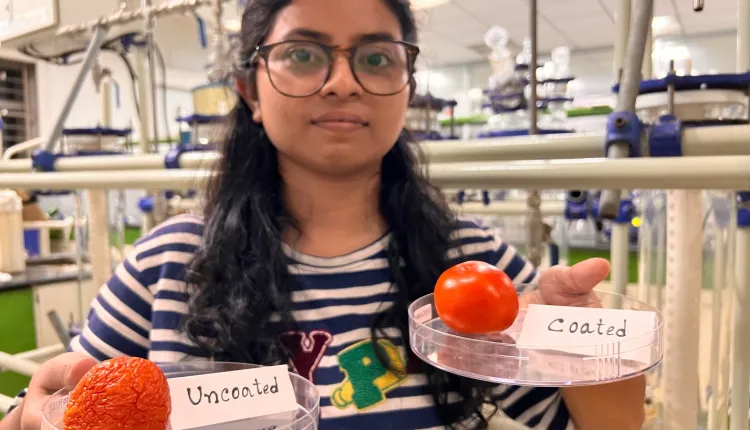
IIT Guwahati Scientists Develop Biodegradable, Edible Coatings That Extends The Shelf Life Of Fruits And Vegetables
- Campus Updates
- 29 Aug, 2022
- 821
Indian Institute of Technology Guwahati researchers led by Prof. Vimal Katiyar, Department of Chemical Engineering and Center for Excellence in Sustainable Polymers (CoE-SusPol), have developed an edible coating to extend the shelf-life of fruits and vegetables .
This coating material, which will prevent wastage, was tested on vegetables such as potato, tomato, green chili and strawberries, Khasi Mandarin, Apples, pineapples, Kiwifruits and were found to keep these vegetables fresh for nearly two months.
The IIT Guwahati Researchers believe that their development could help the country meet the Sustainable Development Goal (SDG) target 12.3 that is aimed at reducing food losses along the production and supply chains, including post-harvest losses.
The research team included Prof. Vimal Katiyar and Prof. Vaibhav V. Goud, Department of Chemical Engineering, IIT Guwahati and CoE-SusPol, IIT Guwahati, along with their research scholars Ms. Kona Mondal, Ms. Tabli Ghosh, Ms. Mandavi Goswami, Ms. Shikha Sharma and Sonu Kumar.
The results of this research have been published in the prestigious journals including Royal Society of Chemistry Advances (https://doi.org/10.1039/D2RA00949H), Food Packaging and shelf life, Food Chemistry, IJBM, ACS-JAFC and American Chemical Society’s Food Science and Technology (https://doi.org/10.1021/acsfoodscitech.2c00174 ).
Highlighting the need for such research, Prof. Vimal Katiyar, Department of Chemical Engineering, IIT Guwahati, and CuSPol, IIT Guwahati, said, “According to the Indian Council of Agricultural Research, between 4.6 and 15.9% of fruits and vegetables go waste post-harvest, partly due to poor storage conditions. In fact, post-harvest loss in certain produce items like potato, onion and tomato which could be as high as 19%, which results in high prices for this highly consumed commodity.”
The IIT Guwahati team used a mix of a micro-algae extract and polysaccharides to produce protective, edible films for coating on vegetables and fruits. The marine microalgae called Dunaliella tertiolecta is known for its antioxidant properties and has various bioactive compounds such as carotenoids, proteins, and polysaccharides.
It is also used as a source of algal oil, which is used as a non-animal source of omega-3 fatty acid, and is being considered as a source of biofuel. After the oil is extracted, the residue is usually discarded.
The researchers used extracts from this residue in formulating their film, in combination with chitosan. Chitosan, a carbohydrate, also has antimicrobial and antifungal properties and can be made into edible film.
The properties of films with varying algal extract contents were analysed and compared with controls. The fabricated edible films displayed a superior antioxidant activity, total phenolic content, water vapor barrier property, thermal stability, and mechanical strength. They also had excellent UV-Vis light-blocking property.
Further, multiple other customised edible coating formulations are developed to enhance the shelf-life of produces based on the requirement.
The researchers also tested the biosafety of these coatings by treating BHK-21 cells with these coating materials. BHK-21 cells are derived from the kidneys of baby hamsters and are used for studying the toxicity effects of various materials. Their tests showed that these coating materials were nontoxic and could be safely used as edible food packaging materials.
Speaking about the developed biodegradable coating, Prof. Vimal Katiyar, Department of Chemical Engineering, IIT Guwahati, “The newly-developed coatings can be mass-produced and are unique. They are very stable to light, heat and temperature up to 40oC, edible and can be safely eaten as part of the product formulation and do not add unfavorable properties to it. They retain the texture, color, appearance, flavor, nutritional value and microbial safety of the fruit or vegetable that has been coated, thereby enhancing their shelf life to several weeks to months”.
The researchers tested the coatings on a range of vegetables, including potato, tomato, green chilies, Khasi Mandarin, Apples and strawberries (both sliced and whole). The coatings can also be directly coated on the vegetable, or made into a vegetable storage pouch, and in both cases, the shelf-life of the vegetables can be extended. It is simple and elegant dip coating technique with no significant cost added to the post-harvest processing.
These studies suggest direct application of the edible coating on the vegetables will definitely help to extend shelf life under the ambient condition on certain fruits and vegetables as claimed in Indian patent application nos. 202131013650 & 202131013653.
